The AnandTech Coffee Lake Review: Initial Numbers on the Core i7-8700K and Core i5-8400
by Ian Cutress on October 5, 2017 9:00 AM EST- Posted in
- CPUs
- Intel
- Core i5
- Core i7
- Core i3
- 14nm
- Coffee Lake
- 14++
- Hex-Core
- Hyperthreading
Benchmarking Performance: CPU Office Tests
The office programs we use for benchmarking aren't specific programs per-se, but industry standard tests that hold weight with professionals. The goal of these tests is to use an array of software and techniques that a typical office user might encounter, such as video conferencing, document editing, architectural modeling, and so on and so forth.
All of our benchmark results can also be found in our benchmark engine, Bench.
Chromium Compile (v56)
Our new compilation test uses Windows 10 Pro, VS Community 2015.3 with the Win10 SDK to compile a nightly build of Chromium. We've fixed the test for a build in late March 2017, and we run a fresh full compile in our test. Compilation is the typical example given of a variable threaded workload - some of the compile and linking is linear, whereas other parts are multithreaded.
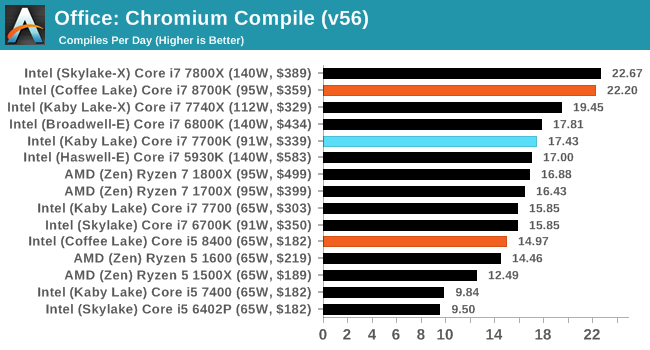
For our compile test, it would appear that the extra memory width afforded by the quad-channel memory of Skylake-X can have a direct benefit in compile performance.
PCMark 10
PCMark 10 is the 2017 update to the family favorite, PCMark 8. PCMark 8 has been part of our test bed since the latest update in Q1. For the most part it runs well, although for some processors it doesn’t recognize, some tests will not complete, leading to holes in our benchmark data (there’s also an odd directory quirk in one test that causes issues). The newest version, PCMark 10, is the answer.
The new test is adapted for more 2016/2017 workflows. With the advent of office applications that perform deeper compute tasks, or the wave of online gamers and streamers, the idea behind PCMark 10 is to give a better ‘single number’ result that can provide a comparable metric between systems. Single metrics never tell the whole story, so we’re glad that Futuremark provides a very detailed breakdown of what goes on.
Ganesh’s article on PCMark 10 goes into more detail than I will here, but the ‘Extended Benchmark’ runs through four different sets of tests: Essential, Productivity, Creation and Gaming. Each of these have sub-test results as well, including startup performance, web performance, video conferencing, photo/video editing, spreadsheets, rendering, and physics, which you can find in Bench.
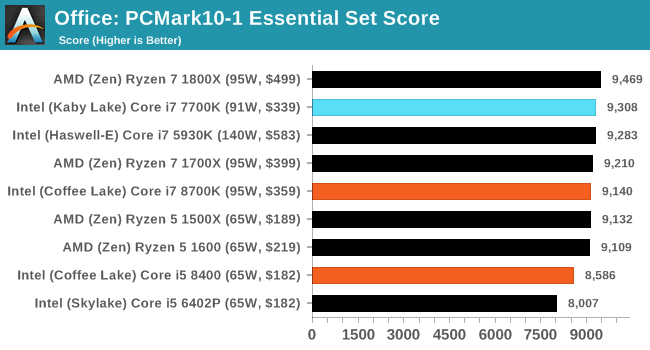

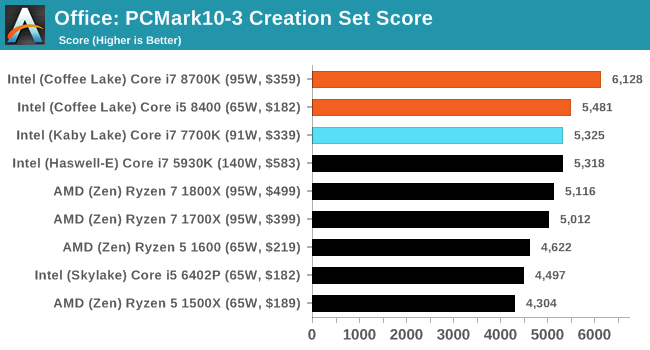
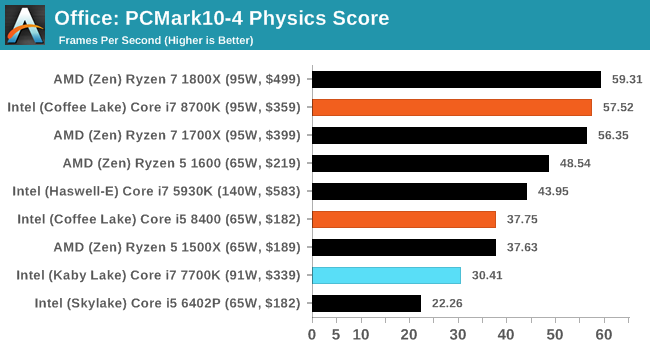
PCMark8: link
Despite originally coming out in 2008/2009, Futuremark has maintained PCMark8 to remain relevant in 2017. On the scale of complicated tasks, PCMark focuses more on the low-to-mid range of professional workloads, making it a good indicator for what people consider 'office' work. We run the benchmark from the commandline in 'conventional' mode, meaning C++ over OpenCL, to remove the graphics card from the equation and focus purely on the CPU. PCMark8 offers Home, Work and Creative workloads, with some software tests shared and others unique to each benchmark set.
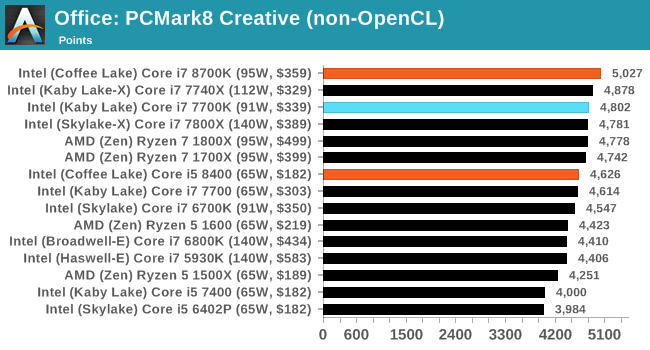
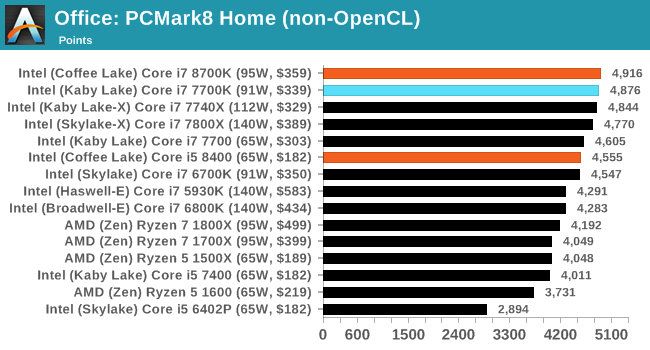
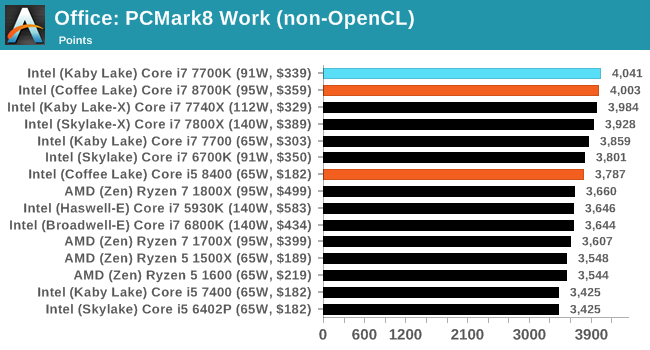










222 Comments
View All Comments
Koenig168 - Friday, October 6, 2017 - link
Hmm ... rather disappointing that Anandtech did not include Ryzen 1600/X until called out by astute readers.mkaibear - Friday, October 6, 2017 - link
...apart from including all the data in their benchmark tool, which they make freely available, you mean? They put in the CPUs they felt that were most relevant. The readership disagreed, so they changed it from their benchmark database. That level of service is almost unheard of in the industry and all you can do is complain. Bravo.Koenig168 - Friday, October 6, 2017 - link
Irrelevant. While I agree with most of what you said, that does not change the fact that Anandtech did not include Ryzen 1600/X until called out by astute readers. To make things a little clearer for you, the i7-8700 is a 6C/12T processor. The Ryzen 1600 is a 6C/12T processor. Therefore, a comparison with the Ryzen 1600 is relevant.You should have addressed the point I made. Instead all you can do is complain about my post. Bravo. (In case this goes over your head again, that last bit is added just to illustrate how pointless such comments are.)
mkaibear - Saturday, October 7, 2017 - link
So your point is, in essence, "they didn't do what I wanted them to do so they're damned for all time".They put up the comparison they felt was relevant, then someone asked them to include something different - so they did it. They listened to their readers and made changes to an article to fix it.
Should they have put the R5 in the original comparison? Possibly. I can see arguments either way but if pushed I'd have said they should have done - but since even the 1600X gets beaten by the 8400 in virtually every benchmark on their list (as per https://www.anandtech.com/bench/product/2018?vs=20... they would then have been accused by the lurking AMD fanboys of having picked comparisons to make AMD look bad (like on every other article where AMD gets beaten in performance).
So what are you actually upset about? That they made an editorial decision you disagree with? You can't accuse them of hiding data since they make it publicly accessible. You can't accuse them of not listening to the readers because they made the change when asked to. Where's the issue here?
mkaibear - Saturday, October 7, 2017 - link
OK on further reading it's not "virtually every" benchmark on the list, just more than half. It's 50% i5 win, 37% R5 win, 12% tied. So not exactly a resounding triumph for the Ryzen but not as bad as I made it out to be.In the UK the price differential is about £12 in favour of the i5, although the motherboard is about £30 more expensive (though of course Z370 is a lot more fully featured than B650) so I think pricing wise it's probably a wash - but if you want gaming performance on anything except Civ VI then you'd be better off getting the i5.
...oh and if you don't want gaming performance then you'll need to buy a discrete graphics card with the R5 which probably means the platform costs are skewed in favour of Intel a bit (£25 for a GF210, £32 for a R5 230...)
watzupken - Saturday, October 7, 2017 - link
As mentioned when I first called out this omission, I would think comparing a 6 vs 4 core irrelevant. This is what AnandTech recommended to lookout for on page 4 "Core Wars": Core i5-8400 vs Ryzen 5 1500X.You be the judge if this makes sense when there is a far better competition/ comparison between the i5 8400 vs R5 1600. Only when you go reading around and you realized that hey, the i5 8400 seems to be losing in some areas to the 1600. I give AnandTech the benefit of the doubt, so I am done debating what is relevant or not.
KAlmquist - Friday, October 6, 2017 - link
The Anandtech benchmark tool confirms what Ryan indicated in the introduction: the i7-8700k wins against the 1600X across the board, due faster clocks and better IPC. The comparison to the i5-8400 is more interesting. It either beats the 1600X by a hair, or loses rather badly. I think the issue is the lack of hyperthreading on the i5-8400 makes the 1600X the better all-around performer. But if you mostly run software that can't take advantage of more than 6 threads, then the i5-8400 looks very good.Personally, I wouldn't buy i5-8400 just because of the socket issue. Coffee Lake is basically just a port of Skylake to a new process, but Intel still came out with a new socket for it. Since I don't want to dump my motherboard in a landfill every time I upgrade my CPU, Intel needs a significantly superior processor (like they had when they were competing against AMD's bulldozer derivatives) to convince me to buy from them.
GreenMeters - Friday, October 6, 2017 - link
So Intel still isn't getting their head out of their rear and offering the option of a CPU that trades all the integrated GPU space for additional cores? Moronic.mkaibear - Friday, October 6, 2017 - link
Integrated graphics make up more than 70% of the desktop market. It's even greater than that for laptops. Why would they sacrifice their huge share of that 70% in order to gain a small share of the 30%? *that* would be moronic.In the meantime you can know that if you buy a desktop CPU from Intel it will have an integrated GPU which works even with no discrete graphics card, and if you need one without the integrated graphics you can go HEDT.
Besides, the limit for Intel isn't remotely "additional space", they've got more than enough space for 8/10/12 CPU cores - it's thermal. Having an integrated GPU which is unused doesn't affect that at all - or arguably it gives more of a thermal sink but I suspect in truth that's a wash.
Zingam - Saturday, October 7, 2017 - link
We need a completely new PC architecture - you need more CPU cores - add more CPU cores, you need more GPU cores add more GPU cores, all of them connected via some sort of Infinity fabric like bus and sharing a single RAM. That should be possible to implement. Instead of innovating Intel is stuck in the current 80s architecture introduced by IBM.